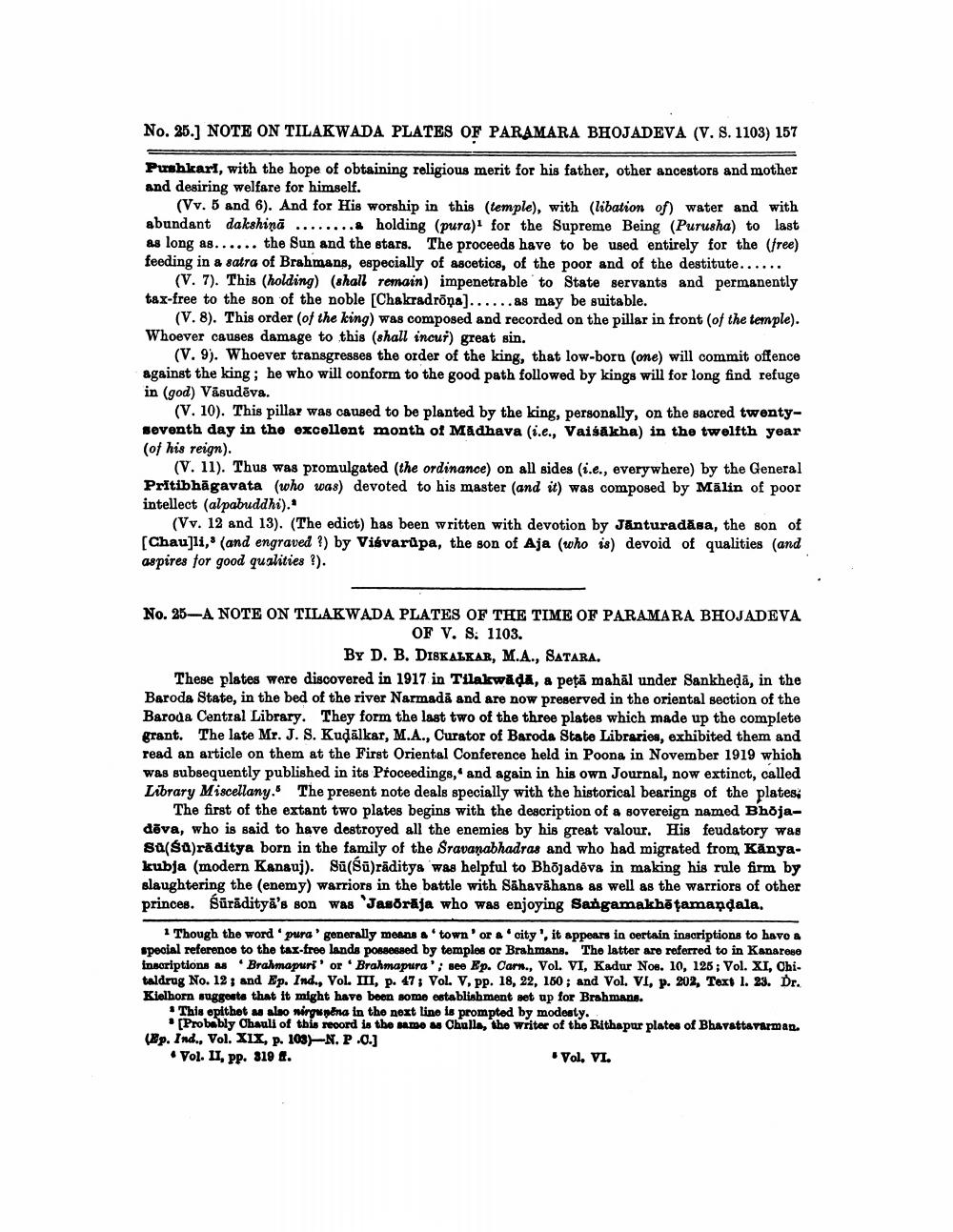________________
No. 25.] NOTE ON TILAKWADA PLATES OF PARAMARA BHOJADEVA (V. S. 1103) 157
Pushkari, with the hope of obtaining religious merit for his father, other ancestors and mother and desiring welfare for himself.
(Vv. 5 and 6). And for His worship in this (temple), with (libation of) water and with abundant dakshina ........a holding (pura) for the Supreme Being (Purusha) to last as long as...... the Sun and the stars. The proceeds have to be used entirely for the (free) feeding in a satra of Brahmans, especially of ascetics, of the poor and of the destitute......
(V. 7). This (holding) (shall remain) impenetrable to State servants and permanently tax-free to the son of the noble [Chakradrona]......as may be suitable.
(V. 8). This order (of the king) was composed and recorded on the pillar in front (of the temple). Whoever causes damage to this (shall incur) great sin.
(V. 9). Whoever transgresses the order of the king, that low-born (one) will commit offence against the king; he who will conform to the good path followed by kings will for long find refuge in (god) Vasudeva.
(V. 10). This pillar was caused to be planted by the king, personally, on the sacred twentyseventh day in the excellent month of Madhava (i.e., Vaisakha) in the twelfth year (of his reign).
(V. 11). Thus was promulgated (the ordinance) on all sides (i.e., everywhere) by the General Pritibhāgavata (who was) devoted to his master (and it) was composed by Mälin of poor intellect (alpabuddhi).
(Vv. 12 and 13). (The edict) has been written with devotion by Janturadāsa, the son of [Chaulli, (and engraved ?) by Visvarapa, the son of Aja (who is) devoid of qualities (and aspires for good qualities ?).
No. 25-A NOTE ON TILAKWADA PLATES OF THE TIME OF PARAMARA BHOJADEVA OF V. S. 1103.
By D. B. DISKALKAR, M.A., SATARA.
These plates were discovered in 1917 in Tilakwādā, a peța mahal under Sankheḍā, in the Baroda State, in the bed of the river Narmada and are now preserved in the oriental section of the Baroda Central Library. They form the last two of the three plates which made up the complete grant. The late Mr. J. S. Kuḍālkar, M.A., Curator of Baroda State Libraries, exhibited them and read an article on them at the First Oriental Conference held in Poona in November 1919 which was subsequently published in its Proceedings, and again in his own Journal, now extinct, called Library Miscellany. The present note deals specially with the historical bearings of the plates.
The first of the extant two plates begins with the description of a sovereign named Bhojadēva, who is said to have destroyed all the enemies by his great valour. His feudatory was sa(Sa)räditya born in the family of the Sravanabhadras and who had migrated from, Kanyakubja (modern Kanauj). Su(Su)raditya was helpful to Bhōjadeva in making his rule firm by slaughtering the (enemy) warriors in the battle with Sahavahana as well as the warriors of other princes. Sūrāditya's son was 'Jasōrāja who was enjoying Sangamakhetamaṇḍala.
1 Though the word 'pura' generally means a 'town' or a 'city', it appears in certain inscriptions to have a special reference to the tax-free lands possessed by temples or Brahmans. The latter are referred to in Kanarese inscriptions as Brahmapuri' or 'Brahmapura'; see Ep. Carn., Vol. VI, Kadur Nos. 10, 125; Vol. XI, Chitaldrug No. 12; and Ep. Ind., Vol. III, p. 47; Vol. V, pp. 18, 22, 150; and Vol. VI, p. 202, Text 1. 23. Dr. Kielhorn suggests that it might have been some establishment set up for Brahmans.
This epithet as also nirgunena in the next line is prompted by modesty.
[Probably Chauli of this record is the same as Chulla, the writer of the Rithapur plates of Bhavattavarman. (Ep. Ind., Vol. XIX, p. 103)-N. P .C.] Vol. II, pp. 319 .
Vol. VI.




